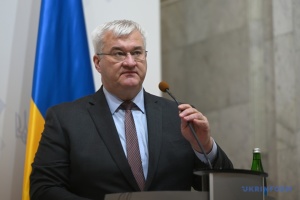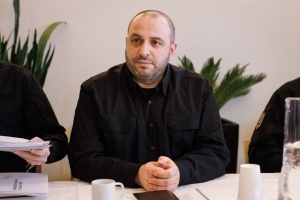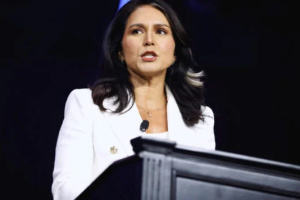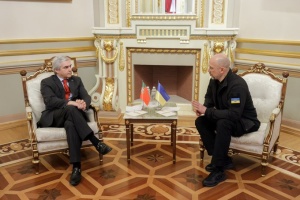
Riyadh talks: Where do statements from Washinton, Moscow and Kyiv coincide and where not?
Experts strongly doubt that the Russian Federation, which has a history of violating similar agreements, never mind declarations, will not violate them again
On March 23-25, the United States held separate negotiations with Ukrainian and Russian delegations over three days in Riyadh, Saudi Arabia. The meetings were held in the form of "shuttle diplomacy", where US negotiators shuttled between the two delegations (the Americans spoke twice with the Ukrainians - before and after they spoke with the Russians on March 23 and 25).
Who participated:
From the Ukrainian side - Minister of Defense of Ukraine Rustem Umerov, Deputy Head of the Presidential Office Pavlo Palisa, military and energy experts.
From the United States side -- The head of European and Russian affairs at the National Security Council, Andrew Peak and State Department’s Policy Planning Director Michael Anton. Secretary of State Marco Rubio and Trump's national security adviser Michael Waltz also traveled to Saudi Arabia.
The Russian Federation -- Federation Council Committee on International Affairs Grigory Karasin and adviser to the director of Russia's Federal Security Service (FSB) Sergey Beseda.
The key issues in negotiations:
cease-fire on critical infrastructure;
a full 30-day ceasefire;
a maritime cease-fire in the Black Sea.
The outcomes reached:
Joint statements. There are four of them, including two based on the results of the meeting between the Ukrainian and US delegations.
It is important to emphasize that, in terms of content, US and Ukraine statements are 95 percent identical and consist of five points, namely:
Safety of navigation in the Black Sea - the United States and Ukraine have agreed to ensure safe navigation, eliminate the use of force, and prevent the use of commercial vessels for military purposes in the Black Sea.
A halt on strikes on energy infrastructure -- the United States and Ukraine agreed to develop measures for implementing President Trump’s and President Zelensky’s agreement to ban strikes against energy facilities of Russia and Ukraine.
Involvement of third countries -- the United States and Ukraine welcome the good offices of third countries with a view toward supporting the implementation of the energy and maritime agreements.
The United States and Ukraine will continue working toward achieving a durable and lasting peace.
Exchange of prisoners of war and repatriation of Ukrainian children -- the United States and Ukraine agreed that the United States remains committed to helping achieve the exchange of prisoners of war, the release of civilian detainees, and the return of forcibly transferred Ukrainian children.
Both statements said that the United States reiterated President Donald J. Trump’s imperative that the killing on both sides of the Russia-Ukraine conflict must stop, as the necessary step toward achieving an enduring peace settlement. To that end, the United States will continue facilitating negotiations between both sides to achieve a peaceful resolution, in line with the agreements made in Riyadh.
However, there is a notable difference in the US and Ukraine statements regarding the halt on the use of force in the Black Sea. Kyiv statement says that Russian navy ships sailing beyond the Eastern Black Sea area will be considered a violation and Ukraine could “exercise [the] right to self-defense" if Russian warships move westward from the eastern part of the Black Sea, to which the Washington statement makes no reference.
Regarding the statements issued by the Russian Federation and the United States... Both also consist of five points. But the overall coincidence is lower at 80 percent, namely:
Safe navigation in the Black Sea.
Both statements contain provisions on the safety of navigation, the prevention of the use of force and the use of commercial vessels for military purposes in the Black Sea.
The difference is that the Russian statement specifies control through the inspection of vessels.
Russian agricultural and fertilizer exports.
White House statement says the United States would “help restore Russia’s access to the world market for agricultural and fertilizer exports, lower maritime insurance costs, and enhance access to ports and payment systems for such transactions.”
In its own statement, the Kremlin said the halt on the use of force in the Black Sea would take effect after several specific actions are in place, demanding detailed measures that were not expressly mentioned by the White House. They included the lifting of sanctions against Rosselkhozbank, Russia’s state-owned agricultural lender, and other financial institutions, their reconnection to the SWIFT payments system, as well as the lifting of restrictions on financing, insurance and maintenance of Russian-flagged vessels.
A pause in strikes on energy facilities.
White House and Kremlin readouts, while containing an agreement on the prohibition of strikes on energy facilities of Russia and Ukraine, include a small but substantial difference. The US statement said the leaders “agreed that the movement to peace will begin with an energy and infrastructure cease-fire,” while the Russian statement described a narrower halt to attacks on “energy infrastructure.” Furthermore, the Russian version adds a validity period (30 days with the possibility of extension or withdrawal in case of violation).
Involvement of third countries.
Both sides welcome the good offices of third countries with a view toward supporting the implementation of the energy and maritime agreements.
Achieving a sustainable and long-lasting peace.
Both statements share a common point that the sides would continue working toward achieving a durable and lasting peace.
In general, four out of five points of the US-Russia and US-Ukraine statements are more or less identical. But something is missing. The Washington and Moscow statements are both missing a point regarding the exchange of prisoners of war and the repatriation of Ukrainian children, and the statements from Ukraine and the United States make no reference to Russian agricultural and fertilizer exports.
There was no sign of a direct agreement between Ukraine and Russia, potentially increasing the chances of differing interpretations, and Ukrainian President Volodymyr Zelensky criticized aspects of the US-Russia agreement, saying: "As far as we know, the Russians raised the issue of the American side helping the Russians transport their agricultural…produce. That is about ports, tariffs, and so on,” he said. “We did not agree to this…. We believe that this is a weakening of positions and a weakening of sanctions."
First comments from experts.
Political analyst Yuriy Bohdanov is in general positive about the final statements following the meeting between the Ukrainian and American delegations: “Good, but I have little faith in implementation.”
As for the maritime ceasefire in the Black Sea, it will most likely be implemented. “But I am doubtful that this will open the way to a broader ceasefire,” Bohdanov commented.
Ihor Reiterovych, political scientist, says that they seem to have agreed on something, but... “Firstly, everyone’s statements are different. Secondly, how it will be implemented is not very clear. Turn to the US? Knowing how Trump selectively treats facts...” - he ironizes.
Comment from defense analyst Mykhailo Samus is also somewhat ironical (towards Russia): “It seems that even the Russians did not expect such progress: the US is lifting sanctions against Russia simply because they will not (supposedly) violate international maritime law in the Black Sea. But, as Musk says: Wow! Putin’s task is being thwarted. How to drag out time under such circumstances where the Americans do not even give themselves an opportunity to get their heads around? And seriously... If conditions will be able to be created to bar Russian warships from moving westward from the eastern part of the Black Sea, it will be already a success.”
Mr Samus continues to comment: “There was a suspicion that, after a ceasefire on the ground is achieved, the Russian Black Sea Fleet would return to its strategy of hybrid dominance over the Black Sea.”
“If so, they will not be able to even hold naval maneuvers in the western part [of the Black Sea], which is a big blow to their tactics of blockading the maritime areas in the Black Sea under the guise of naval exercises,” Samus comments.
Here comes comment from Kyrylo Sazonov, political analyst and Armed Forces of Ukraine officer: “We agreed not to sink peaceful ships in the Black Sea. That's it... The US vowed to help the Russian Federation sell grain and fertilizers. This is a minus, albeit not a principal one. A kind of candy to stop a child from whining. The candy is tasty, that's it. Well, we agreed to negotiate... I myself think that Russia will break the truce and lie again that there was a training center, a biolaboratory, etc. There is no faith in them.”
Preliminary conclusion: We have a new round of talks and joint final statements, the content of which raises lots of questions as to their practical implementation. Ukrainian-American agreements are more focused on shipping safety, a ban on strikes against energy infrastructure, and on peace initiatives. At the same time, the Russian-American statements contain provisions on easing economic sanctions against the Russian Federation, which has caused criticism among the Ukrainian expert community. And tomorrow we will see whether counterparts, most particularly in Europe, will join them. General skepticism over the implementation of the agreements remains high, considering that Russia has repeatedly violated similar agreements.
Myroslav Liskovych, Kyiv




